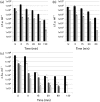A novel antimicrobial peptide significantly enhances acid-induced killing of Shiga toxin-producing Escherichia coli O157 and non-O157 serotypes
- PMID: 21454368
- PMCID: PMC3167915
- DOI: 10.1099/mic.0.047365-0
A novel antimicrobial peptide significantly enhances acid-induced killing of Shiga toxin-producing Escherichia coli O157 and non-O157 serotypes
Abstract
Shiga toxin-producing Escherichia coli (STEC) colonizes the human intestine, causing haemorrhagic colitis and haemolytic uraemic syndrome (HUS). Treatment options are limited to intravenous fluids in part because sublethal doses of some antibiotics have been shown to stimulate increased toxin release and enhance the risk of progression to HUS. Preventative antimicrobial agents, especially those that build on the natural antimicrobial action of the host defence, may provide a better option. In order to survive the acid stress of gastric passage, STEC is equipped with numerous acid resistance and DNA repair mechanisms. Inhibition of acid-induced DNA repair may offer a strategy to target survival of ingested STEC. We report here that brief pretreatment with a novel antimicrobial peptide, which was previously shown to inhibit bacterial DNA repair, significantly and profoundly reduces survival of acid-stressed O157 : H7 and non-O157 : H7 STEC seropathotypes that are highly associated with HUS. Reduction in survival rates of STEC range from 3 to 5 log. We also show that peptide/acid treatment results in little or no increase in toxin production, thereby reducing the risk of progression to HUS. This study identifies the peptide wrwycr as a potential new candidate for a preventative antimicrobial for STEC infection.
Figures




Similar articles
-
Antimicrobial resistance of Shiga toxin (verotoxin)-producing Escherichia coli O157:H7 and non-O157 strains isolated from humans, cattle, sheep and food in Spain.Res Microbiol. 2005 Aug;156(7):793-806. doi: 10.1016/j.resmic.2005.03.006. Epub 2005 Apr 22. Res Microbiol. 2005. PMID: 15921895
-
Shiga toxin-induced haemolytic uraemic syndrome and the role of antibiotics: a global overview.J Infect. 2019 Aug;79(2):75-94. doi: 10.1016/j.jinf.2019.05.018. Epub 2019 May 28. J Infect. 2019. PMID: 31150744 Review.
-
Serotypes, virulence genes, and intimin types of Shiga toxin (verotoxin)-producing Escherichia coli isolates from healthy sheep in Spain.J Clin Microbiol. 2003 Apr;41(4):1351-6. doi: 10.1128/JCM.41.4.1351-1356.2003. J Clin Microbiol. 2003. PMID: 12682113 Free PMC article.
-
Shiga toxin-producing Escherichia coli O171:H25 strain isolated from a patient with haemolytic uraemic syndrome.Acta Microbiol Immunol Hung. 2012 Jun;59(2):215-24. doi: 10.1556/AMicr.59.2012.2.6. Acta Microbiol Immunol Hung. 2012. PMID: 22750781
-
Methods for the detection and isolation of Shiga toxin-producing Escherichia coli.Symp Ser Soc Appl Microbiol. 2000;(29):133S-143S. doi: 10.1111/j.1365-2672.2000.tb05341.x. Symp Ser Soc Appl Microbiol. 2000. PMID: 10880188 Review.
Cited by
-
Modulation of the enterohemorrhagic E. coli virulence program through the human gastrointestinal tract.Virulence. 2013 May 15;4(4):315-23. doi: 10.4161/viru.24318. Epub 2013 Apr 3. Virulence. 2013. PMID: 23552827 Free PMC article. Review.
-
Escherichia coli enterobactin synthesis and uptake mutants are hypersensitive to an antimicrobial peptide that limits the availability of iron in addition to blocking Holliday junction resolution.Microbiology (Reading). 2012 Feb;158(Pt 2):547-559. doi: 10.1099/mic.0.054361-0. Epub 2011 Nov 17. Microbiology (Reading). 2012. PMID: 22096151 Free PMC article.
-
Enterohemorrhagic Escherichia coli and a Fresh View on Shiga Toxin-Binding Glycosphingolipids of Primary Human Kidney and Colon Epithelial Cells and Their Toxin Susceptibility.Int J Mol Sci. 2022 Jun 21;23(13):6884. doi: 10.3390/ijms23136884. Int J Mol Sci. 2022. PMID: 35805890 Free PMC article. Review.
-
Potentiation of Antibiotics by a Novel Antimicrobial Peptide against Shiga Toxin Producing E. coli O157:H7.Sci Rep. 2020 Jun 22;10(1):10029. doi: 10.1038/s41598-020-66571-z. Sci Rep. 2020. PMID: 32572054 Free PMC article.
-
Dps Protects Enterohemorrhagic Escherichia coli against Acid-Induced Antimicrobial Peptide Killing.J Bacteriol. 2020 May 11;202(11):e00114-20. doi: 10.1128/JB.00114-20. Print 2020 May 11. J Bacteriol. 2020. PMID: 32229529 Free PMC article.
References
-
- Azaro M. A., Landy A. (2002). Lambda integrase and the lambda Int family. In Mobile DNA II, pp. 118–148. Edited by Craig N. L., Craigie R., Gellert M., Lambowitz A. M. Washington, DC: American Society for Microbiology.
-
- Banatvala N., Griffin P. M., Greene K. D., Barrett T. J., Bibb W. F., Green J. H., Wells J. G., Hemolytic Uremic Syndrome Study Collaborators (2001). The United States national prospective hemolytic uremic syndrome study: microbiologic, serologic, clinical, and epidemiologic findings. J Infect Dis 183, 1063–1070. 10.1086/319269. - DOI - PubMed
Publication types
MeSH terms
Substances
Grants and funding
LinkOut - more resources
Full Text Sources

